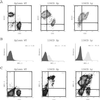Onset of natural killer cell lymphomas in transgenic mice carrying a truncated HMGI-C gene by the chronic stimulation of the IL-2 and IL-15 pathway
- PMID: 11427729
- PMCID: PMC35452
- DOI: 10.1073/pnas.141224998
Onset of natural killer cell lymphomas in transgenic mice carrying a truncated HMGI-C gene by the chronic stimulation of the IL-2 and IL-15 pathway
Abstract
Rearrangements of the high mobility group protein I-C (HMGI-C) gene, consisting in the loss of the carboxyl-terminal tail, have been frequently detected in benign human tumors of mesenchymal origin. We have previously demonstrated that transgenic (TG) mice carrying a truncated HMGI-C construct (HMGI-C/T) exhibit a giant phenotype together with a predominantly abdominal/pelvic lipomatosis. Here, we report that HMGI-C/T TG mice develop natural killer (NK)-T/NK cell lymphomas starting from 12 months of age. We found an increased expression of IL-2 and IL-15 proteins and their receptors in these lymphomas, and we demonstrate that HMGI-C/T protein positively regulates their expression in vitro. Therefore, the HMGI-C/T-mediated chronic stimulation of the IL-2/IL-15 pathway could be responsible for the onset of NK-T/NK cell lymphomas in HMGI-C/T TG mice.
Figures






References
Publication types
MeSH terms
Substances
Grants and funding
LinkOut - more resources
Full Text Sources
Molecular Biology Databases
Miscellaneous

